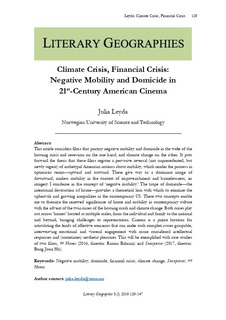| dc.contributor.author | Leyda, Julia | |
| dc.date.accessioned | 2020-01-03T07:29:04Z | |
| dc.date.available | 2020-01-03T07:29:04Z | |
| dc.date.created | 2020-01-02T14:48:40Z | |
| dc.date.issued | 2019 | |
| dc.identifier.citation | Literary Geographies. 2019, 5 (2), 129-147. | nb_NO |
| dc.identifier.issn | 2397-1797 | |
| dc.identifier.uri | http://hdl.handle.net/11250/2634681 | |
| dc.description.abstract | This article considers films that portray negative mobility and domicide in the wake of the housing crisis and recession on the one hand, and climate change on the other. It puts forward the thesis that these films register a pervasive reversal (not unprecedented, but newly urgent) of archetypal American notions about mobility, which render the process in optimistic terms—upward and outward. These give way to a dominant image of downward, aimless mobility in the context of impoverishment and homelessness, an imagery I condense in the concept of ‘negative mobility.’ The trope of domicide—the intentional destruction of home—provides a theoretical lens with which to examine the upheavals and growing inequalities in the contemporary US. These two concepts enable me to theorize the renewed significance of home and mobility in contemporary culture with the advent of the twin crises of the housing crash and climate change. Both crises play out across ‘homes’ located at multiple scales, from the individual and family to the national and beyond, bringing challenges to representation. Cinema is a prime location for articulating the kinds of affective scenarios that can make such complex issues graspable, interweaving emotional and visceral engagement with more considered intellectual responses and (sometimes) aesthetic pleasures. This will be exemplified with case studies of two films, 99 Homes (2014, director: Ramin Bahrani) and Snowpiercer (2017, director: Bong Joon Ho). | nb_NO |
| dc.language.iso | eng | nb_NO |
| dc.publisher | Literary Geographies | nb_NO |
| dc.rights | Navngivelse 4.0 Internasjonal | * |
| dc.rights.uri | http://creativecommons.org/licenses/by/4.0/deed.no | * |
| dc.title | Climate Crisis, Financial Crisis: Negative Mobility and Domicide in 21st-Century American Cinema | nb_NO |
| dc.type | Journal article | nb_NO |
| dc.type | Peer reviewed | nb_NO |
| dc.description.version | publishedVersion | nb_NO |
| dc.source.pagenumber | 129-147 | nb_NO |
| dc.source.volume | 5 | nb_NO |
| dc.source.journal | Literary Geographies | nb_NO |
| dc.source.issue | 2 | nb_NO |
| dc.identifier.cristin | 1765384 | |
| dc.description.localcode | Copyright (c) 2019 Julia Leyda. Open Access | nb_NO |
| cristin.unitcode | 194,62,35,0 | |
| cristin.unitname | Institutt for kunst- og medievitenskap | |
| cristin.ispublished | true | |
| cristin.fulltext | original | |
| cristin.qualitycode | 1 | |

